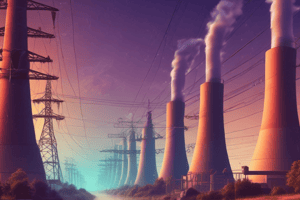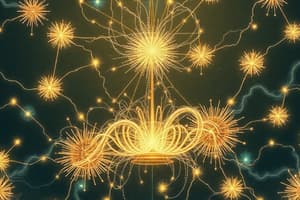Podcast
Questions and Answers
Elaborate on the quantum mechanical phenomena that underpin the generation of electricity via semiconductor-based photovoltaic cells, detailing the roles of electron-hole recombination and the impact of varying band gaps.
Elaborate on the quantum mechanical phenomena that underpin the generation of electricity via semiconductor-based photovoltaic cells, detailing the roles of electron-hole recombination and the impact of varying band gaps.
Photovoltaic electricity generation is fundamentally reliant on the quantum mechanical properties of semiconductors. Incident photons with energy greater than the semiconductor's band gap excite electrons from the valence band to the conduction band, creating electron-hole pairs. Charge separation occurs at the p-n junction due to the built-in electric field. The efficiency of this process is affected by the band gap energy and the rate of electron-hole recombination, where electron-hole recombination can limit the number of charge carriers available for creating electricity.
Critically analyze the statement: 'All forms of electricity generation, regardless of source (e.g., hydroelectric, thermal, wind), are fundamentally based on the principles of electromagnetic induction.' Detail any theoretical exceptions or conditions under which this statement might not hold true.
Critically analyze the statement: 'All forms of electricity generation, regardless of source (e.g., hydroelectric, thermal, wind), are fundamentally based on the principles of electromagnetic induction.' Detail any theoretical exceptions or conditions under which this statement might not hold true.
The statement is largely accurate, as most widespread electricity generation methods – hydroelectric, thermal (via steam), and wind – rely on electromagnetic induction. However, it's not universally true. Electrochemical and piezoelectric electricity generation do not rely on electromagnetic induction. Direct conversion methods, like thermoelectric generators, converting heat directly into electrical energy based on the Seebeck effect do not use generators, and therefore do not rely on electromagnetic induction. In biological systems, ATP synthase generates ATP (a form of 'biological electricity') through chemiosmosis, also bypassing electromagnetic induction.
Formulate a theoretical scenario where static electricity could be harnessed for sustained, large-scale power generation, addressing the major obstacles currently preventing such application, such as charge dissipation and energy storage limitations.
Formulate a theoretical scenario where static electricity could be harnessed for sustained, large-scale power generation, addressing the major obstacles currently preventing such application, such as charge dissipation and energy storage limitations.
Hypothetically, a large-scale static electricity generator might utilize a continuously replenished triboelectric surface. Imagine vast areas covered with materials that generate high static charges upon contact and separation, driven by environmental forces (e.g., wind or tides). Nano-structured materials could maximize charge density. However, the great technical challenge is continuous and efficient harvesting of this charge to avoid dissipation, coupled with storage solutions beyond current capacitor technology. Supercapacitors with extremely high energy density, or novel phase-change materials that stabilize charge, would be essential.
Analyze the implications of quantum entanglement on the future of electrical energy transmission, considering its potential to circumvent classical limitations imposed by resistance and signal degradation over long distances.
Analyze the implications of quantum entanglement on the future of electrical energy transmission, considering its potential to circumvent classical limitations imposed by resistance and signal degradation over long distances.
Elaborate on the relationship between the macroscopic phenomenon of current electricity and the underlying microscopic behavior of electrons in a conductive material, accounting the Drude model and deviations arising from quantum mechanics, focusing on Bloch waves.
Elaborate on the relationship between the macroscopic phenomenon of current electricity and the underlying microscopic behavior of electrons in a conductive material, accounting the Drude model and deviations arising from quantum mechanics, focusing on Bloch waves.
Compare and contrast the energy conversion efficiency of a modern combined cycle gas turbine (CCGT) power plant with an ideal Carnot engine operating between the same maximum and minimum temperatures. Account for the irreversibilities present in the actual CCGT cycle.
Compare and contrast the energy conversion efficiency of a modern combined cycle gas turbine (CCGT) power plant with an ideal Carnot engine operating between the same maximum and minimum temperatures. Account for the irreversibilities present in the actual CCGT cycle.
Describe how the principles of topological insulators could be leveraged to innovate in the context of electrical energy transmission or storage, focusing on unique properties that could circumvent limitations of conventional conductors or semiconductors.
Describe how the principles of topological insulators could be leveraged to innovate in the context of electrical energy transmission or storage, focusing on unique properties that could circumvent limitations of conventional conductors or semiconductors.
Flashcards
Electricity
Electricity
A form of energy resulting from charged particles moving through wires.
Atom's Components
Atom's Components
Atoms consist of a nucleus, protons, neutrons, and electrons.
How Electricity is Made
How Electricity is Made
Transforming energy into electrical energy by turning a turbine connected to a generator.
Sources to produce electricity
Sources to produce electricity
Signup and view all the flashcards
Current Electricity
Current Electricity
Signup and view all the flashcards
Static Electricity
Static Electricity
Signup and view all the flashcards
Energy
Energy
Signup and view all the flashcards
Study Notes
- Electricity is a form of energy resulting from charged particles carried by wires.
- Atoms are the smallest particles, containing a nucleus, protons, neutrons, and electrons.
- Electricity is produced by converting energy into electrical energy using a turbine connected to a generator.
- The turbine's rotation generates electricity.
Sources of Energy for Electricity Production
- Heated Water: Produces steam to turn turbines.
- Waterfalls and Dams: Utilize water flow to rotate turbines.
- Wind Power: Harnesses wind to turn turbines.
Types of Electricity
- Current Electricity: Electricity moving from one place to another, made or controlled by humans.
- Static Electricity: Build-up of electrical charge on an object.
Energy
- Energy: The ability to do work.
- Potential Energy: Stored energy in an object.
- Kinetic Energy: Energy in action.
Studying That Suits You
Use AI to generate personalized quizzes and flashcards to suit your learning preferences.
Description
Explore the basics of electricity, its production, and different types, including current and static electricity. Learn about the fundamental concepts of energy, potential energy, and kinetic energy. Discover various energy sources for electricity production such as water, wind, and heated water.




